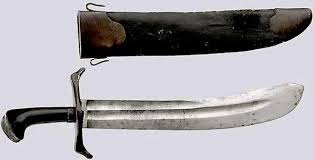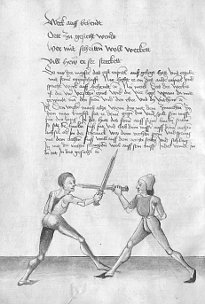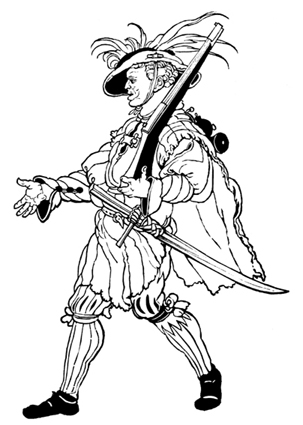
| myArmoury.com is now completely member-supported. Please contribute to our efforts with a donation. Your donations will go towards updating our site, modernizing it, and keeping it viable long-term.
Last 10 Donors: Anonymous, Daniel Sullivan, Chad Arnow, Jonathan Dean, M. Oroszlany, Sam Arwas, Barry C. Hutchins, Dan Kary, Oskar Gessler, Dave Tonge (View All Donors) |
| Author |
Message |
Jean Henri Chandler

|
 Posted: Tue 23 Nov, 2010 2:32 pm Post subject: A mess of messers Posted: Tue 23 Nov, 2010 2:32 pm Post subject: A mess of messers |
 |
|
So I think there was an interesting technical / historical discussion emerging about Messers in the Makers and Manufactuters forum, maybe we can continue that here.
I have been interested in attempting to classify these weapons myself and try to determine their role in society and warfare but have found it challenging.
One point of confusion I ran into is that there is a whole family of messer-like weapons which seem to be related, in that they share the following features:
A long single-edged cutting blade
A long handle like a knife handle
A nagel
So I've noticed there seem to be what look like at least 7 distinct types of the 'messer'' family that I've tentatively identified. This mostly applies to the 15th Century when the earliest currently known messer fencing manuals appeared. These namess come from German terms I've seen in historical documents as well as on modern German language auction sites, and these various types all overlap somewhat, which I think has caused some of the confusion around this class of weapons.
The Hauswehr is a long, broad knife with a nagel which was used as the primary home-defense for a farmer or in some cases, a prestige weapon owned by a burgher in Renaisance HRE or Poland. This weapon is shaped like a grossmesser only smaller, with a 12"-16" blade length. I think some of these were made fancy like these from Tods Stuff...

or more simply like this antique

But in both cases had some utility as a tool while being primarily intended as a weapon. Like a bayonett for a 20th Century soldier.
The Baurenwehr is a similar long, broad knife with a nagel which was used as a work-knife by farmers and rural laborers of some distinction or social standing. I think this played a role similar in many respects to what a machete does in Central America today, both as a tool and as a prestige weapon for a certain social class (poor people of some means, essentially). This weapon is shaped like a grossmesser or sometimes is more pointed a lot like an Afghan "khyber knife", except with a nagel. Same size as a Hauswehr.
The Rugger was a hunting knife similar to a Baurenwehr, but specifcially designed for killing and / or skinning animals. These could be larger, average maybe a bit bigger or broader in the blade..

The Coltel (I think related to the Italian term Colatessa and later, possibly to the Cutlass) was also a hunting knife but with a very broad blade, which often did not come to a point, maybe rounded off or squared off. It has a nagel. I think this one is specifically for skinning and butchering animals rather than for killing. Theere are also some of these which look a lot like a bowie knife. Very similar weapons were also used in Burgundy and Northern Spain.


German auction sites refer to these types as ruggers or hauswehrs but I have come to think of them as a distinct subtype
The Grossmesser is the term I specifically apply to the shorter fighting messers, 16-28" long, sometimes with broad blades, such as you see in Durer, sometimes with narrower blades like in Lechkukner . These usually seem to be single-edged with no false-edge.

The Langenmesser is for a longer fighting messer, 28"-36" long, some of these are very long. They usually have a large nagel sometimes a clamshell type, often without quillons but sometimes big quillons like in Talhoffer. They also seem to have some with broad blades (in artwork) and some with quite narrrow blades (antiques at auction sites)
The Kriegsmesser is of course the infamous very large two-handed big war-messer, with a partial false edge and up to 48" long, though most seem to be a bit shorter around 42"-44" or so.
 
The Kriegsmesser also overlaps with the large Hungarian Infantry Saber (don't know of any period name for this weapon), which is very similar two handed weapon but more curved and with no partial false edge, and with the Schwiesersabel, which is a slender Swiss messer with a complex hilt.
And then you have the Falchion which is a completely different animal I think, and also has many distinct subtypes.
J
Books and games on Medieval Europe Codex Integrum
Codex Guide to the Medieval Baltic Now available in print
|
|
  |
 |
Paul Hansen

|
 Posted: Wed 24 Nov, 2010 11:22 am Post subject: Posted: Wed 24 Nov, 2010 11:22 am Post subject: |
 |
|
Not at all a bad overview, but I wonder about the distinction between the Hauswehr and the Bauernwehr. I think that these two are essentially the same. The name is also similar: "house defence" and "farmer's defence".
I'm also not sure that I agree with this:
| Quote: | | The Baurenwehr (...) was used as a work-knife by farmers and rural laborers of some distinction or social standing. I think this played a role similar in many respects to what a machete does in Central America today, both as a tool and as a prestige weapon for a certain social class (poor people of some means, essentially). |
Like I said in the other thread, I don't see much evidence or reason for these weapons to be used as tools. There is and was no rain forest in Europe. There were specialised tools available. Other than those tools, messers were a part of dress and often with some kind of decoration. And why risk damaging your main self-defence weapon when you have all the tools you need at hand?
|
|
  |
 |
|
Christopher Treichel
Location: Metro D.C. Joined: 14 Jan 2010
Posts: 268
|
 Posted: Wed 24 Nov, 2010 1:02 pm Post subject: Posted: Wed 24 Nov, 2010 1:02 pm Post subject: |
 |
|
Some places also had restrictions and or requirements on the type of Knife Dagger or Sword and weapon/ tool worn by social status in an area...
Many cities hung fake knives next to the city gate so all who entered would know how big a knife they could carry...
What was the local right to defend ones home and what weapons was a propertied person required to maintain?
|
|
  |
 |
|
Ken Speed
|
 Posted: Thu 25 Nov, 2010 3:29 am Post subject: Posted: Thu 25 Nov, 2010 3:29 am Post subject: |
 |
|
I agree with Paul in part when he said, "....... but I wonder about the distinction between the Hauswehr and the Bauernwehr. I think that these two are essentially the same. The name is also similar: "house defence" and "farmer's defence"."
I think I disagree with him when he says that these knives weren't tools, it seems to me that some of them were clearly tools and others had evolved from tools to prestige items. That beautifully made broad bladed knife is just a cleaver in party clothes when it comes down to it.
It seems to me that we see a fairly clear line of tools evolving into prestige items and/or weapons here. In the woolier parts of America it was common at one time for a man to have his everyday Bowie and a fancy one for "Sunday Best" or Saturday night. My understanding is that "messer" means knife but in this case it seems that when these implements were referred to as messers they were becoming primarily weapons.
I think the comparison to machetes was somewhat unfortunate and a little misleading, I think the simpler knives can be compared to the Bowie or the Hudson's Bay Knife both a tool and a weapon while fancier and often larger ones were specialized as weapons.
.
|
|
  |
 |
|
Allen W
|
 Posted: Thu 25 Nov, 2010 12:00 pm Post subject: Posted: Thu 25 Nov, 2010 12:00 pm Post subject: |
 |
|
The terms Grossemesser, Langesmasser and Kriegsmesser are interchangeable. The distinction seems to be a very recent result of Albion's naming convention and spread for the sake of having terms to differentiate the categories you site. Of course they could also just be addressed as messers as they are in Talhoffer. Incidently the two-handed messers could have partial back edges and raised back edges as well.
The nagel is not a necessary feature and is as likely to be a side ring instead.
Hauswehr and Bauerwehr are likewise interchangeable as I have seen them used.
I have only seen the term rugger applied to the narrow pointy variety.
Just my experience.
|
|
  |
 |
Paul Hansen

|
 Posted: Thu 25 Nov, 2010 12:41 pm Post subject: Posted: Thu 25 Nov, 2010 12:41 pm Post subject: |
 |
|
Regarding the messer / bauernwehr as a tool, I simply do not see the point of carrying something so big and cumbersome. There was no need for a machete-like tool in Europe. There were specialised and much better tools for woodworking, harvesting, pruning etc. So even though a farmer may need a long knife for some tasks, these tasks would not be so frequent that it would make sense to wear this long knife on a belt, as part of daily wear. Also, a tool does not need a cross-guard or a nagel.
To me, a tool is something that belongs in a shed or in a toolbox, and not on a belt, unless it's used extremely often. Like a machete in the rain forest.
I would concede that, like a pocket knife, a messer might occasionally be used as a tool. But then it's a multi-purpose item rather than just a tool. I think that the bowie knife is indeed a reasonable comparison. Anyway, I remain of the opinion that the messer / bauernwehr as discussed here was primarily intended as a self-defence weapon.
| Christopher Treichel wrote: | Some places also had restrictions and or requirements on the type of Knife Dagger or Sword and weapon/ tool worn by social status in an area...
Many cities hung fake knives next to the city gate so all who entered would know how big a knife they could carry... |
Cities were responsible for keeping the peace inside their walls. So think of it like a kind of metal detector at an airport. 
In what respect these rules applied to the citizens of the the city is a different matter, I think. A well-thinking citizen would not risk expulsion just to participate in some knife fight.
But I'm not so sure that any passing nobleman would automatically have the right to keep his weapons inside the walls either.
| Christopher Treichel wrote: | | What was the local right to defend ones home |
That depends a great deal on the circumstances, I think. A burgher inside the city walls would mainly depend on the town guard, like most people nowadays depend on the police. A free farmer living somewhere out in the country didn't have anybody to go to for help. A serf would appeal to his feudal lord for aid, if he had time for that, and otherwise, bad luck, I guess...
|
|
  |
 |
Bill Grandy
myArmoury Team


|
 Posted: Thu 25 Nov, 2010 1:41 pm Post subject: Posted: Thu 25 Nov, 2010 1:41 pm Post subject: |
 |
|
| Paul Hansen wrote: | | Also, a tool does not need a cross-guard or a nagel. |
Actually, in Germany most knives had a nagel, even if it were a small eating knife. It is not a function of a weapon. Likewise, many "weapon" messers had no crossguard.
I think we should keep in mind that people of the period did think a messer was distinct from a sword, even if they used the exact same techniques. For example, in the Nuremburg Hausbuch, we have this:
"As the sword is taken and founded in the long knife, whoever wants to learn to fence with the knife should first note and know that the fundamentals and principals with the sword also apply to the knife."
(Please forgive my terrible translation skills)
In other words, the author is saying that the messer is used with the same techniques as a sword, yet in saying so he's indirectly making the point that they are considered different tools that use the same techniques.
| Ken Speed wrote: | | I think the comparison to machetes was somewhat unfortunate and a little misleading, I think the simpler knives can be compared to the Bowie or the Hudson's Bay Knife both a tool and a weapon while fancier and often larger ones were specialized as weapons. |
I think this is a good point. In the other thread, Jean said my messer was like a machete, and I said that's essentially what messers were, and that sparked a discussion. But I think you're right in saying a machete isn't the best analogy.
I don't like this idea that people keep saying tools wouldn't be decorated, because if that's true, then swords wouldn't be decorated either. 
HistoricalHandcrafts.com
-Inspired by History, Crafted by Hand
"For practice is better than artfulness. Your exercise can do well without artfulness, but artfulness is not much good without the exercise.” -anonymous 15th century fencing master, MS 3227a
|
|
   |
 |
Jean Thibodeau

|
 Posted: Thu 25 Nov, 2010 2:18 pm Post subject: Posted: Thu 25 Nov, 2010 2:18 pm Post subject: |
 |
|
| Bill Grandy wrote: |
I think this is a good point. In the other thread, Jean said my messer was like a machete, and I said that's essentially what messers were, and that sparked a discussion. But I think you're right in saying a machete isn't the best analogy.
|
Yes and I didn't mean it to start an argument only that a very thin 1/16" blade reminds me somewhat of the thin blade of a machete needing only a narrow bevel at the edge to sharpen and no primary bevel and just a sharpened very thin flat.
Also, I would add that the quality of steel, craftmanship and heat treat of Bill's messer is greatly better than the common cheap stamped out Wallmart purchased machete.
The only thing in common being a very thin and flexible blade for this specific Messer, so my comparison is limited to only this point.   
You can easily give up your freedom. You have to fight hard to get it back!
|
|
  |
 |
Mark T

|
 Posted: Sat 27 Nov, 2010 3:27 am Post subject: Posted: Sat 27 Nov, 2010 3:27 am Post subject: |
 |
|
This thread at SFI contains some discussion that folks might find relevant here: http://forums.swordforum.com/showthread.php?t=56047
Chief Librarian/Curator, Isaac Leibowitz Librarmoury
Schallern sind sehr sexy!
|
|
  |
 |
|
Samuel Bena
Location: Slovakia Joined: 10 Dec 2007
Posts: 94
|
 Posted: Sun 28 Nov, 2010 6:13 am Post subject: Re: A mess of messers Posted: Sun 28 Nov, 2010 6:13 am Post subject: Re: A mess of messers |
 |
|
Greetings Jean,
Interesting musing on a somewhat obscure topic 
| Jean Henri Chandler wrote: |
The Kriegsmesser also overlaps with the large Hungarian Infantry Saber (don't know of any period name for this weapon),
|
Do you mayhap have any picture of the said Hungarian Infantry Saber or a reference to it? (I wonder what makes that saber an infantry one to begin with) - I have never heard of such a thing.
Cheers,
Samuel
|
|
   |
 |
|
|
You cannot post new topics in this forum
You cannot reply to topics in this forum
You cannot edit your posts in this forum
You cannot delete your posts in this forum
You cannot vote in polls in this forum
You cannot attach files in this forum
You can download files in this forum
|
All contents © Copyright 2003-2024 myArmoury.com — All rights reserved
Discussion forums powered by phpBB © The phpBB Group
Switch to the Basic Low-bandwidth Version of the forum
|

